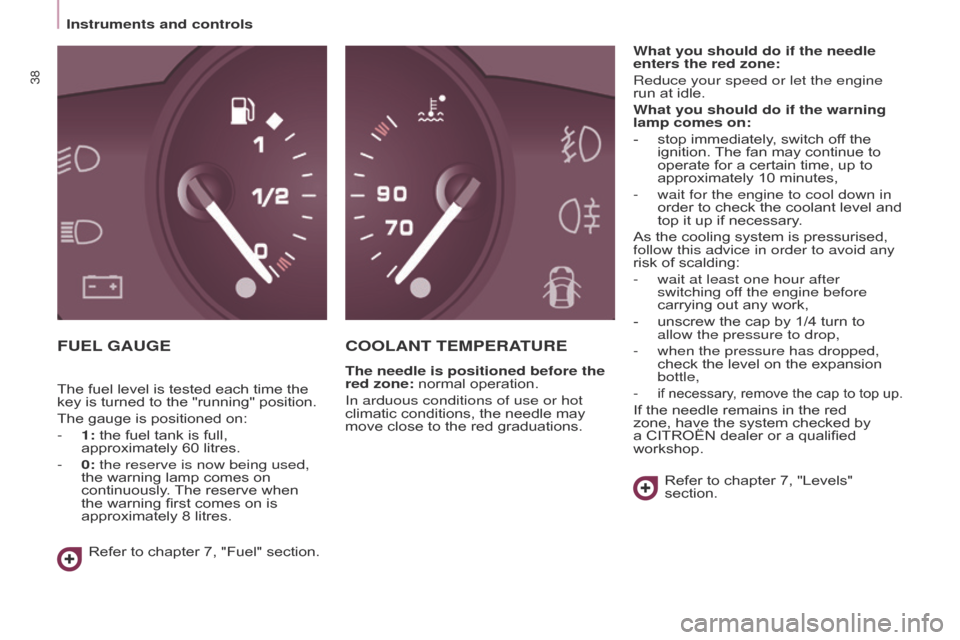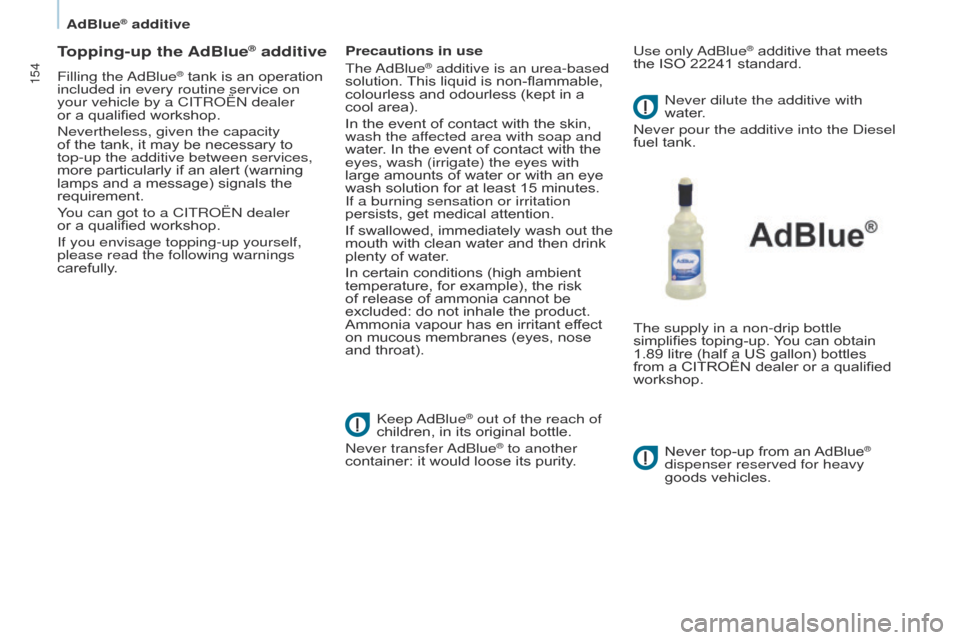fuel reserve Citroen BERLINGO MULTISPACE RHD 2015 2.G Owner's Manual
[x] Cancel search | Manufacturer: CITROEN, Model Year: 2015, Model line: BERLINGO MULTISPACE RHD, Model: Citroen BERLINGO MULTISPACE RHD 2015 2.GPages: 276, PDF Size: 12.21 MB
Page 40 of 276

Berlingo_2_VP_en_Chap03_Pret-a-partir_ed02-2014
38
FuEL GAuGEcOOLA nt t EMPE r Atur E
the needle is positioned before the
red zone: normal operation.
In arduous conditions of use or hot
climatic
conditions, the needle may
move
close to the red graduations.What you should do if the needle
enters the red zone:
Reduce your speed or let the engine
run
at idle.
What you should do if the warning
lamp comes on:
-
stop
immediately, switch off the
ignition.
The
fan may continue to
operate
for a certain time, up to
approximately
10 minutes,
-
wait for the engine to cool down in
order
to check the coolant level and
top
it up if necessary.
As the cooling system is pressurised,
follow this advice in order to avoid any
risk
of scalding:
-
wait at least one hour after
switching of
f the engine before
carrying out any work,
-
unscrew
the cap by 1/4 turn to
allow the pressure to drop,
-
when the pressure has dropped,
check
the level on the expansion bottle,
-
if necessary, remove the cap to top up.
If the needle remains in the red zone,
have the system checked by
a
CITROËN dealer or a qualified
workshop.
Refer
to chapter 7, "Levels"
section.
Refer
to
chapter
7,
"Fuel"
section.
The
fuel
level
is
tested
each
time
the
key
is
turned
to
the
"running"
position.
The
gauge
is
positioned
on:
-
1:
the
fuel
tank
is
full,
approximately
60
litres.
-
0:
the reserve is now being used,
the
warning
lamp
comes
on
continuously
.
The
reserve
when
the
warning
first
comes
on
is
approximately
8
litres.
Instruments and controls
Page 149 of 276

Berlingo_2_VP_en_Chap07_Verification_ed02-2014
147
FILLInG WItH FuEL
Low fuel level
Filling
The fuel tank must be filled with the
engine off.
-
Open
the fuel filler flap.
-
Insert
the key, then turn it a quarter
turn.
-
Remove
the cap and hook it onto
the clip located on the inside of the
flap.
When
filling with fuel, a
mechanical
system prevents
opening
of the left-hand side door.
When
the fuel filler flap is open, ensure
that
no one tries to slide this door.
Once
the flap has been closed, the
sliding
side door may jam, push the
door
to close it then open it.
When
the
minimum
fuel
tank
level is reached, this warning
lamp
comes
on.
You then have
approximately 8 litres of
fuel
remaining.
Fill
up
without
delay
to
avoid
running
out
of
fuel.
Never
risk
driving
until
you
run
out
of
fuel
as
this
may
damage
the
emissions
control
and
injection
systems. A
label affixed to the inside of the flap
reminds
you of the type of fuel to be
used.
Y
ou must fill with at least 5 litres of fuel
for
it to be registered by the fuel gauge.
When
the fuel filler cap is opened,
there
may be a slight air suction noise.
This
vacuum is entirely normal and is
due
to the sealing of the fuel circuit.
When
filling the fuel tank, do not
continue after the 3rd cut-off of the
nozzle.
This
could
cause malfunctions.
The
capacity
of
the
fuel tank is
approximately
60
litres.
-
After
filling
the
fuel tank, lock the
cap
and
close
the flap.
Fuel used for petrol engines
The petrol engines are compatible with E10 bio-petrol (containing 10 %
ethanol), conforming to European
standards
EN 228 and EN 15376.
E85 type fuels (containing up to 85 %
ethanol) are reserved exclusively for
vehicles
marketed for the use of this
type
of fuel (BioFlex vehicles).
The
quality
of the ethanol must comply with
European
standard EN 15293.
Fuel
cHEcKS
7
Page 151 of 276

Berlingo_2_VP_en_Chap07_Verification_ed02-2014
149
AdBLuE® AddItIVE
A
nd S
cr
SYS t EM
FO
r B
L
u
E H dI dIESEL
E
n
GI
n
ES
To assure respect for the environment and conformity with the new Euro 6
emissions
standard, without adversely
af
fecting the performance or fuel
consumption
of Diesel engines,
CITROËN
has taken the decision to
equip
its vehicles with an effective
system
that associates SCR (Selective
Catalytic Reduction) with a particle
filter
(FAP) for the treatment of exhaust
gases.
Presentation of the Scr system
Using an additive called adBlue®
containing urea, a catalytic converter
turns up to 85% of nitrous oxides
(
no
x) into nitrogen and water, which
are
harmless
to
health
and
the
environment.
The
a
dBlue
® additive is held in a
special
tank
located under the boot
at
the
rear
of the vehicle. It has a
capacity
of
17 litres: this provides a
driving
range of about 12 500 miles
(20
000 km), after which an alert
is triggered warning you when the
reserve
remaining is enough for just
1
500
miles
(2 400 km).
d
uring each scheduled service of
your vehicle by a CITR
o Ë n dealer
or
a
qualified workshop, the
AdBlue®
additive
tank
is
refilled
in
order
to
allow
normal
operation
of
the
SCR
system.
If
the
estimated
mileage
between
two services is greater than
12 500 miles
(20
000
km),
we
recommend
that
you
go
to
a
CITROËN
dealer
or
a
qualified
workshop
to
have
the
necessary
top-up
carried
out.
o
nce the a dBlue
® tank is empty, a
system
required by regulations
prevents
starting
of the engine.
If the SCR
is faulty, the level of
emissions
from
your
vehicle will no
longer
meet
the
Euro
6 standard: you
vehicle
becomes
polluting.
In
the
event
of
a
confirmed fault
with
the
SCR
system,
you must go
to
a
CITROËN
dealer
or a qualified
workshop
as
soon
as
possible: after
a
running
distance
of
650 miles
(1
100
km),
a
system
will be triggered
automatically
to
prevent engine
starting.
AdBlue® additive
cHEcKS
7
Page 156 of 276

Berlingo_2_VP_en_Chap07_Verification_ed02-2014
154
topping-up the AdBlue® additive
Filling the adBlue® tank is an operation included in every routine service on
your vehicle by a CITR
o Ë n dealer
or
a
qualified
workshop.
n
evertheless, given the capacity
of
the
tank,
it
may
be necessary to
top-up the additive between services,
more
particularly
if an alert (warning
lamps
and
a
message) signals the
requirement.
Y
ou can got to a CITR o Ë n dealer
or
a
qualified
workshop.
If you envisage topping-up yourself,
please read the following warnings
carefully. Precautions in use
The
a dBlue® additive is an urea-based
solution.
This liquid is non-flammable,
colourless
and odourless (kept in a
cool
area).
In
the
event
of contact with the skin,
wash the af
fected area with soap and
water.
In
the
event of contact with the
eyes, wash (irrigate) the eyes with
large
amounts of water or with an eye
wash
solution for at least 15 minutes.
If a burning sensation or irritation
persists,
get
medical attention.
If
swallowed, immediately wash out the
mouth
with
clean water and then drink
plenty
of
water.
In
certain
conditions (high ambient
temperature,
for example), the risk
of
release
of
ammonia cannot be
excluded:
do not inhale the product.
Ammonia
vapour has en irritant effect
on
mucous
membranes (eyes, nose
and
throat).
k
eep
a
dBlue
® out of the reach of
children,
in
its
original bottle.
n
ever transfer
a
dBlue
® to another
container:
it
would
loose its purity. Use only
a dBlue
® additive that meets the
ISO
22241
standard.
n
ever dilute the additive with
water.
n
ever pour the additive into the d iesel
fuel
tank.
The supply in a non-drip bottle
simplifies
toping-up.
Y
ou can obtain
1.89
litre
(half
a
US gallon) bottles
from
a
CITROËN dealer or a qualified
workshop.Never
top-up from an
AdBlue®
dispenser reserved for heavy
goods
vehicles.
adBlue® additive